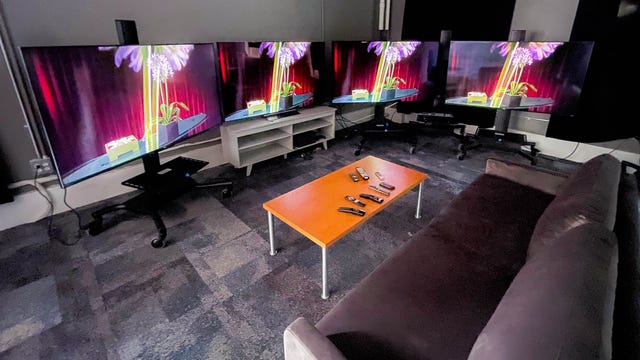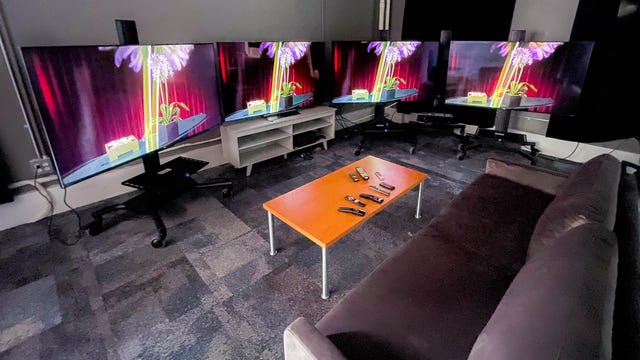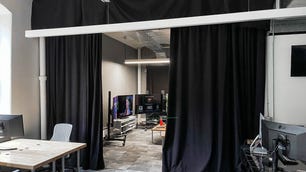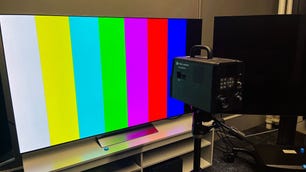With the arrival of summer, the annual TV pricing cycle has reached a high point. The new 2023 models, like the LG C3 OLED TV, were released in spring, but their prices are high. However, most of the 2022 models are still in stock, often with similar features and image quality, not to mention much lower prices. Translation? A 2022 TV, such as the LG C2 OLED, is a better deal. That’s why on this list, most of the models, which represent our top recommendations, are the best TVs for 2023 that were actually released last year.
At CNET, I review TVs side by side in a state-of-the-art testing lab, taking hundreds of measurements with specialized equipment, comparing gaming, home theater and bright-room image quality. My 20 years experience as a TV reviewer helps me determine not just the best TV overall but also the best TV in your price range.
Read more: How We Test TVs
What is the best TV?
The TCL 6-Series Roku TV sits at the top of our list of best TVs for a number of reasons. It offers superb picture quality, an affordable price tag and Roku, the best smart TV system. It also includes gaming features like 4K/120Hz input and variable refresh rate that can get the most out of consoles like the PS5 and Xbox Series X. When a friend asks me what TV to buy from 55 to 85 inches, and money is still an object, I tell them to get the TCL 6-Series.
There are plenty of other excellent choices out there, however, so even though the 6-Series is my current favorite for most people, it might not be right for your preferences or budget.
Best TVs in 2023
Other TVs we’ve tested
LG C3 series OLED TV: As we mentioned above, the C2 from 2022 and C3 from 2023 were basically identical in our tests. Since the price difference between the two LG OLED TVs remains hundreds of dollars, we’re recommending the C2 over the C3 for now. Read our LG C3 OLED TV review.
Sony KD-X80K series: Sony is a prominent brand and its higher-end TVs like the X90J do well in reviews, but the entry-level TV in its 2022 lineup, the X80K, didn’t make the list. It costs around the same as the TCL 6-Series and Samsung Q60 TVs, and had a worse picture than both, with lighter black levels and contrast. It’s definitely not a bad TV, and we liked its Google smart TV system, color accuracy and connectivity, but you can definitely do better for the money. Read our Sony KD-X80K series review.
Amazon Fire TV 4-Series: One of many Fire TVs available for sale, this one is typical of the breed: so-so image quality and a smart TV system that lags behind Roku and Google TV. If you’re a big fan of Alexa voice, or see this TV at a really low price, it might be worthwhile, but otherwise go for the TCL 4-Series. Read our best budget TVs roundup.
How we test TVs
Our TV reviews follow a rigorous, unbiased evaluation process honed over nearly two decades of TV reviews. Our primary TV test lab has specialized equipment for measuring light and color, including a Konica Minolta CS-2000 spectroradiometer, a Murideo Sig-G 4K HDR signal generator and an AVPro Connect 8×8 4K HDR distribution matrix. We use Portrait Displays CalMan Ultimate software to evaluate every TV we review. In every CNET TV review, three or more similar TVs are compared side by side in various lighting conditions playing different media, including movies, TV shows and games, across a variety of test categories, from color to video processing to gaming to HDR. Our reviews also account for design, features, smart TV performance, HDMI input and gaming compatibility, and other factors.
One important aspect of image quality we test is overall brightness. Here’s how it compares in nits across select TVs listed above.
Light output in nits
| TV | Brightest mode (HDR) | Accurate mode (HDR) | Brightest mode (SDR) | Accurate mode (SDR) |
|---|---|---|---|---|
| Samsung QN65Q90B | 3,316 | 1,981 | 2,625 | 974 |
| Hisense U8H | 1,867 | 1,867 | 1,605 | 1,605 |
| TCL 65R655 | 1,387 | 1,194 | 1,292 | 624 |
| Vizio M65QXM-K03 | 939 | 742 | 958 | 608 |
| LG OLED65C2 | 812 | 759 | 413 | 389 |
| Roku TV Plus (65-inch) | 514 | 455 | 579 | 404 |
Check out How We Test TVs for more details.
How to choose a TV
With all of the TVs available today, and all of the technical terms and jargon associated with television technology, it can be tough to figure out what’s important. Here’s a quick guide to help cut through the confusion.
Price: TVs range in price from $100 to more than $2,000. Smaller screens are cheaper, well-known brands are more expensive and spending more money can also get you better image quality. Most entry-level TVs have a good enough picture for most people, but TVs last a long time, so it might be worth spending more to get a better picture. It’s also best to shop for a TV in the fall, when prices are lower.
Screen size: Bigger is better in our book. We recommend a size of at least 43 inches for a bedroom TV and at least 55 inches for a living room or main TV — and 65 inches or larger is best. More than any other “feature,” stepping up in TV screen size is the best use of your money. One of the most common post-TV-purchase complaints we’ve heard is from people who didn’t go big enough. And we almost never hear people complain that their TV is too large.
Capability: Among entry-level TVs the most important feature is what kind of smart TV system the TV uses. Among midrange models, look for a feature including full-array local dimming, mini-LED and 120Hz refresh rate, which (unlike some other extras) do help improve the picture in our experience. And among high-end TVs, OLED technology is your best bet.
For more TV buying advice check out How to Buy a TV.
TV FAQ
We’ll post the answers to commonly asked TV questions below. If you have any others, feel free to reach out on Twitter (@dkatzmaier), or by clicking the little envelope icon on my CNET profile page. Doing so will let you send a message straight to my inbox.



